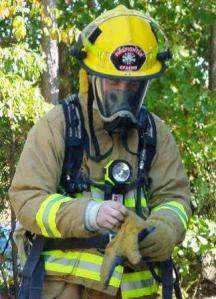By: Robert Avsec
For the last couple of posts I’ve been writing about the customer care skills that every firefighter, officer, EMT, Paramedic, should have for an organization to be successful at developing and maintaining good customer relations with the people they serve. Today, I’d like to tell you a little bit about how my Fire & EMS department (from which I retired in December 2007 as a Battalion Chief) does customer service.
 The concepts of customer service are completely completely congruent with Chesterfield Fire and EMS Department’s (CFEMS) organizational culture and values. See, in CFEMS, you not only receive positive reinforcement for delivering great service to the customer, such actions are an expectation that is supported by the organization through its CARE (Citizens Against Residential Emergencies) Program. So how do the actions of the men and women of CFEMS fit with CARE? First a quick look at how the CARE Program came to be.
The concepts of customer service are completely completely congruent with Chesterfield Fire and EMS Department’s (CFEMS) organizational culture and values. See, in CFEMS, you not only receive positive reinforcement for delivering great service to the customer, such actions are an expectation that is supported by the organization through its CARE (Citizens Against Residential Emergencies) Program. So how do the actions of the men and women of CFEMS fit with CARE? First a quick look at how the CARE Program came to be.
At one time the fire departments of Chesterfield County were staffed ![]() entirely by volunteers and those dedicated volunteers were supported solely through fundraising efforts and the donations of individual citizens who often felt compelled to “write a check” after the fire department had “helped them out of a jam”. (Many volunteer fire departments across the USA still rely on this type of funding to “keep their doors open”).
entirely by volunteers and those dedicated volunteers were supported solely through fundraising efforts and the donations of individual citizens who often felt compelled to “write a check” after the fire department had “helped them out of a jam”. (Many volunteer fire departments across the USA still rely on this type of funding to “keep their doors open”).
 As those independent volunteer fire departments evolved over time–Chesterfield County began adding career personnel to supplement declining volunteer availability in 1969–CFEMS has become one of the premiere combination-staffed departments in the USA. However, the public’s support and generosity –wanting to “write a check” after receiving help from the fire department—did not go away. Many times on the scene of an emergency, or back at the fire station, a citizen we’d helped would want to give us a check for our service. (Anyone who is an employee in the public sector recognizes the ethical dilemma this situation presents: you don’t want to offend the offeror’s generosity by refusing the donation—their tax dollars already fund the department—and you don’t have any means to legally accept it).
As those independent volunteer fire departments evolved over time–Chesterfield County began adding career personnel to supplement declining volunteer availability in 1969–CFEMS has become one of the premiere combination-staffed departments in the USA. However, the public’s support and generosity –wanting to “write a check” after receiving help from the fire department—did not go away. Many times on the scene of an emergency, or back at the fire station, a citizen we’d helped would want to give us a check for our service. (Anyone who is an employee in the public sector recognizes the ethical dilemma this situation presents: you don’t want to offend the offeror’s generosity by refusing the donation—their tax dollars already fund the department—and you don’t have any means to legally accept it).
CFEMS’s response was to create the CARE Program, a 501 (c) non-profit corporation, with the county’s  blessing as the financial management tool that enabled the department to legally accept such donations. (We learned about such a program when some of our officers attended a regional training class in Richmond where Fire Chief Jeff Johnson (Ret.), of the Tualatin Valley (OR) Fire and Rescue Department made a presentation on their program). Funds in the CARE Program, which come from citizen and corporate donations and fundraising efforts—which has its own bank account and is subject to strict auditing procedures to comply with U.S. tax laws—support initiatives that include, but are not limited to:
blessing as the financial management tool that enabled the department to legally accept such donations. (We learned about such a program when some of our officers attended a regional training class in Richmond where Fire Chief Jeff Johnson (Ret.), of the Tualatin Valley (OR) Fire and Rescue Department made a presentation on their program). Funds in the CARE Program, which come from citizen and corporate donations and fundraising efforts—which has its own bank account and is subject to strict auditing procedures to comply with U.S. tax laws—support initiatives that include, but are not limited to:
- Hotel Vouchers. It’s 2 a.m. and a fire has displaced your family of five that includes three children, ages 3-9 years old. The Red Cross chapter that serves Chesterfield County is a wonderful group of people who respond very quickly when called upon to assist in such situations. However, even on a good day it can take upwards of an hour from the time they get the call until they’re on the scene. Not a problem.
Every engine, truck and ambulance in the CFEMS response fleet has hotel  voucher forms on board that are honored—through prior agreements with the establishment—to provide immediate lodging for one night. The officer on-scene completes the voucher and then a staff officer on scene is tasked with “resident relocation”, i.e., going to the hotel with those folks—and providing transportation if necessary—to ensure that everything goes smoothly. (I had the pleasure of being tasked with this assignment on several occasions and I still get a “lump” in my throat thinking about the smiles on the faces of those we’d helped when they realized that the “worst day” of their lives was already just a “bit better”).
voucher forms on board that are honored—through prior agreements with the establishment—to provide immediate lodging for one night. The officer on-scene completes the voucher and then a staff officer on scene is tasked with “resident relocation”, i.e., going to the hotel with those folks—and providing transportation if necessary—to ensure that everything goes smoothly. (I had the pleasure of being tasked with this assignment on several occasions and I still get a “lump” in my throat thinking about the smiles on the faces of those we’d helped when they realized that the “worst day” of their lives was already just a “bit better”).
- Meal Vouchers. Same deal as the above. CFEMS has CARE agreements with local eateries across the county that provide for a meal, not to exceed $50.
- Cash on hand. In addition to the vouchers, every engine, truck and ambulance in the CFEMS response fleet carries $100 in cash for the officer-in-charge to spend as they see fit to act in accordance with one of CFEMS’s core values, “Do the right thing?”
How does that work? I responded with the units in my battalion to a report of a mobile home fire one Christmas Eve. A young family couple with a two-month-old child had escaped safely—because there was a working smoke detector in the home!—but their home was a total loss. The solution? The company officers on scene collected the CARE money from all the apparatus–$400 total—and then they tasked the crew of the ambulance on scene with taking Dad, Mom, and baby to a nearby 24-hour Wal-Mart to obtain clothing, disposal diapers, basic baby supplies, etc. (They’d gotten out of their home with nothing but their pajamas and the temperature was hovering around 30 degrees).
When did I approve all of this? I didn’t have to. The “rescue effort” was already well under way by the time I arrived at the scene. Are there “rules” for the CARE Program? Yes, there are and they are more focused on the financial accountability, i.e., creating the legally necessary paper-trial. When it comes to implementation, we already had the basic principle: Do the right thing.
- Are your actions going to help someone who’s in trouble?
- Will those actions reflect positively on you, the department, and the county?
If the answer to those questions is “Yes”, then take action.
 Fire & EMS Leader Pro The job of old firefighters is to teach young firefighters how to become old firefighters!
Fire & EMS Leader Pro The job of old firefighters is to teach young firefighters how to become old firefighters!